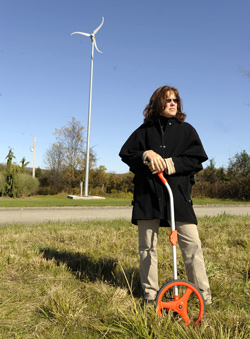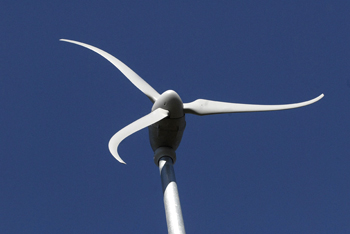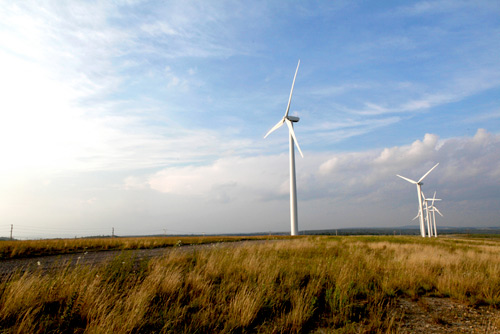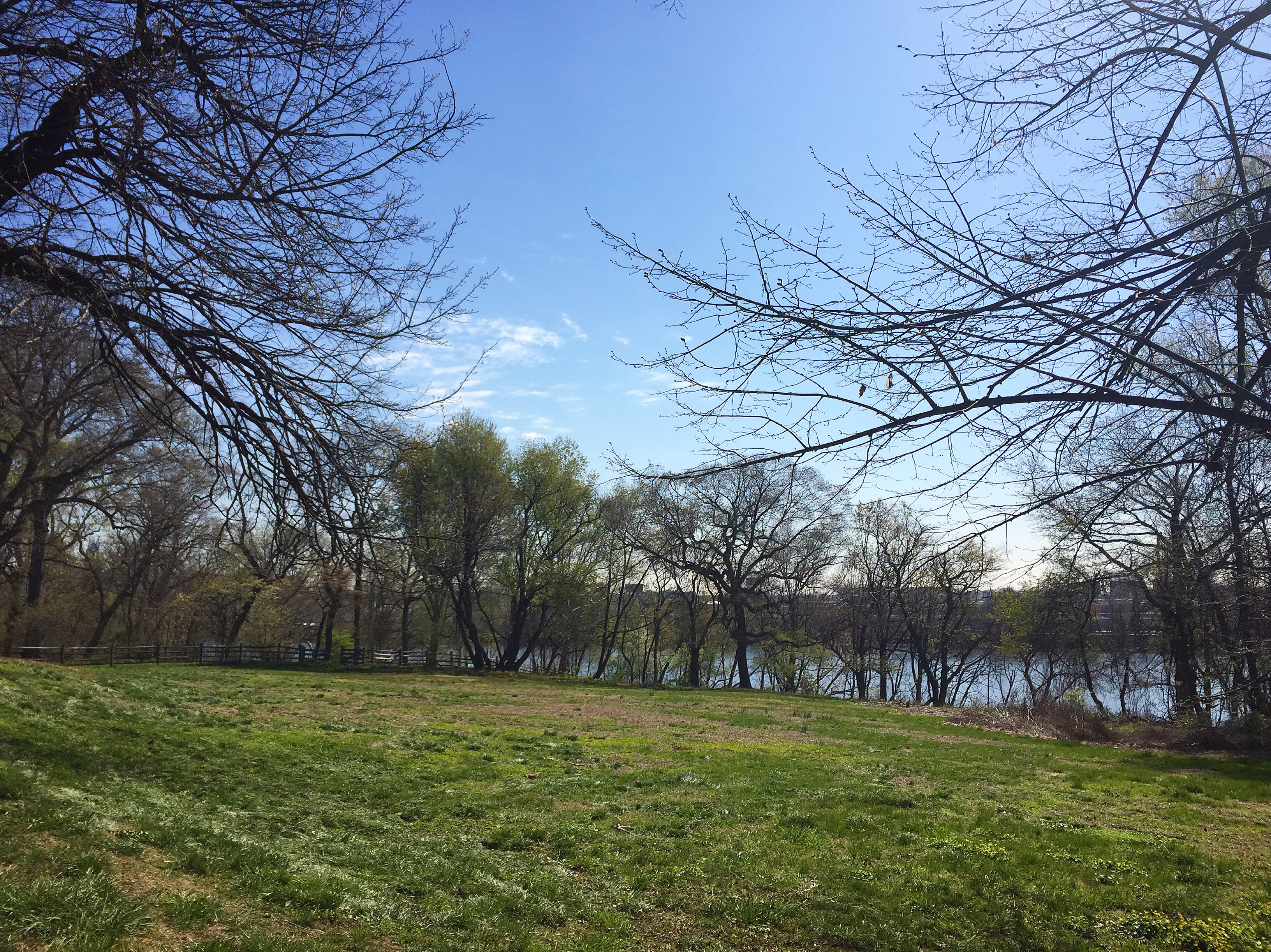Though it might seem logical on blustery fall days when gusts of air barrel down city streets, leaf squalls blow up and cold drafts creep through even the tightest-buttoned coats, harnessing the wind in urban areas is difficult.
But it’s not impossible, according to Sandy Babuka. She would know: every one of her days is spent educating property owners interested in installing wind turbines.
As the president of Trehab Renewable Energy in Montrose, Susquehanna County, she’s more familiar with 60-foot turbine towers mounted on open tracts of land. The company formed in February 2008 as a for-profit offshoot of Trehab, a regional drug treatment and rehabilitation nonprofit. In the 21 months since then, Babuka has been involved in installing 32 turbines throughout the six-county region that includes: Sullivan, Susquehanna, Wayne, Wyoming, Bradford and Tioga.
But she’d like to see more smaller turbines affixed to buildings, particularly in urban areas where zoning can get squirrely but manmade wind tunnels are ripe for the exploiting.
 “I wish somebody would try that out,” she says, fresh from a day out discussing the merits of installing a new turbine and inspecting existing ones. “It will just supplement what you take from the grid.”
“I wish somebody would try that out,” she says, fresh from a day out discussing the merits of installing a new turbine and inspecting existing ones. “It will just supplement what you take from the grid.”
Urban turbine options look more like weathervanes than windmills: The small blades are attached to short poles, which are installed on building roofs and provide, at most, 200 kilowatt hours per month. That, however, must be adjusted by the turbine’s conversion factor, which Babuka estimated is around 65 percent, so the end result is probably more like 130 kilowatt hours per month.
Electricity generator output is measured in kilowatt hours, a unit that translates to the amount of electricity used each hour by a 1,000-watt appliance, or 20 appliances, each of 50 watts, all running simultaneously.
While they create a fraction of the estimated 750 kwh created by the large turbines Babuka usually deals with, they’re also much cheaper and smaller, meaning that many of them can be grouped together and provide comparable amounts of electricity.
One big difference between the two types of turbines, she noted, is that the smaller turbines can’t connect to the electricity grid, meaning any power it creates couldn’t be sold back to the utility–a process known as net metering. Instead, the power would either simply reduce use from the grid or would need to be saved in batteries for later use, and that’s a bit of a problem.
“There isn’t a battery storage system that exists that will store enough energy more than an hour and a half,” she says, but adds: “The smaller guys could probably be hooked on a battery system easier than the big guys.”
 Another big difference is installation. While the larger systems likely benefit from a professional installation, “with the smaller ones, it’s not a concern; it’s a self install,” she says.
Another big difference is installation. While the larger systems likely benefit from a professional installation, “with the smaller ones, it’s not a concern; it’s a self install,” she says.
And it doesn’t affect the tax credit. The federal stimulus package rolled out earlier this year allows consumers and small businesses to take a tax credit of 30 percent of the cost for installing a wind turbine. For self installs, Babuka says, that can include labor and materials costs as long as it documented.
Though predictable, an important concern is catching the wind. “It’s all about the clean winds. You can’t have obstructed wind,” she says. “Any time it hits a pole or building, it rolls or becomes turbulent. When you’ve got rooftops and all kinds of angles coming at you, it really distorts the wind.”
That can “tremendously” affect performance, she says. “As long as it was able to move and pick up the west and northwest wind, you’d probably do a pretty good job with that one,” she says, noting that the artificial wind tunnels created by straight, tall city streets would likely be “useful” eight months of the year.
Wind is an issue because of the new generation of turbine blades. The old “drag” style airfoil–what you’d expect to see at a farmstead on the prairie–is good for low wind to create high torque to power an operation, such as a pump in a water well. It’s not, however, good at creating electricity. That’s the domain of the “lifting” airfoil – which is what you see on airplanes and modern turbines. Fewer blades make it more efficient at converting higher speed winds into energy.
 Tracking the machines’ performance and tweaking it is one of the services Trehab offers over other companies, Babuka says, and one of the reasons she’s almost constantly on the road. “I’ve got a huge growing family here.”
Tracking the machines’ performance and tweaking it is one of the services Trehab offers over other companies, Babuka says, and one of the reasons she’s almost constantly on the road. “I’ve got a huge growing family here.”
The company was the brainchild of Dennis Phelps, the overall executive director of Trehab, who said he’s “very pleased” with the renewable energy component’s expansion. “To just sell them and walk away would be a disservice, whereas Sandy’s providing a more comprehensive service to make sure the turbines work properly,” he says.
“Essentially, we’re a community development agency. We were very concerned about the impact of high energy costs,” Babuka says. “We have a heavy emphasis on education, and, of course, we don’t charge for the education. We think if we’re going to be successful, people need to completely understand it.”
Currently, the wind industry is enough to support two full-time workers at Trehab and perhaps three more subcontractors, he said, but a Duke University report indicates that that number could increase as Americans become more dependent upon wind power. Jobs would be created all along the supply chain, as well.
With the infusion of money from drilling for natural gas in the Marcellus Shale in his region, Phelps is already seeing that occur and hopes it continues.
“The fact that residents are writing checks for $18,500 in this kind of economy is amazing,” he says.
Rory Sweeney writes on energy and the environment when he’s paid to and sits around talking about them when he’s not. Send feedback here.
To receive Keystone Edge free every week, click here.
Photos:
Sandra Babuka, program director of the Trehab Renewable Energy Company.
Sandra Babuka stands with a survey wheel at the site of one of their wind turbine residential installations.
Trehab uses the survey wheel to calculate distances from power lines, tall obstructions and highway setbacks at proposed wind turbine sites, it is used along with GPS to map the best site for turbines.
All Photographs by Brad Bower



